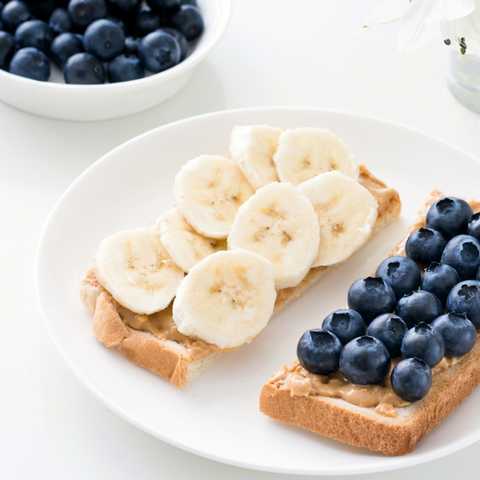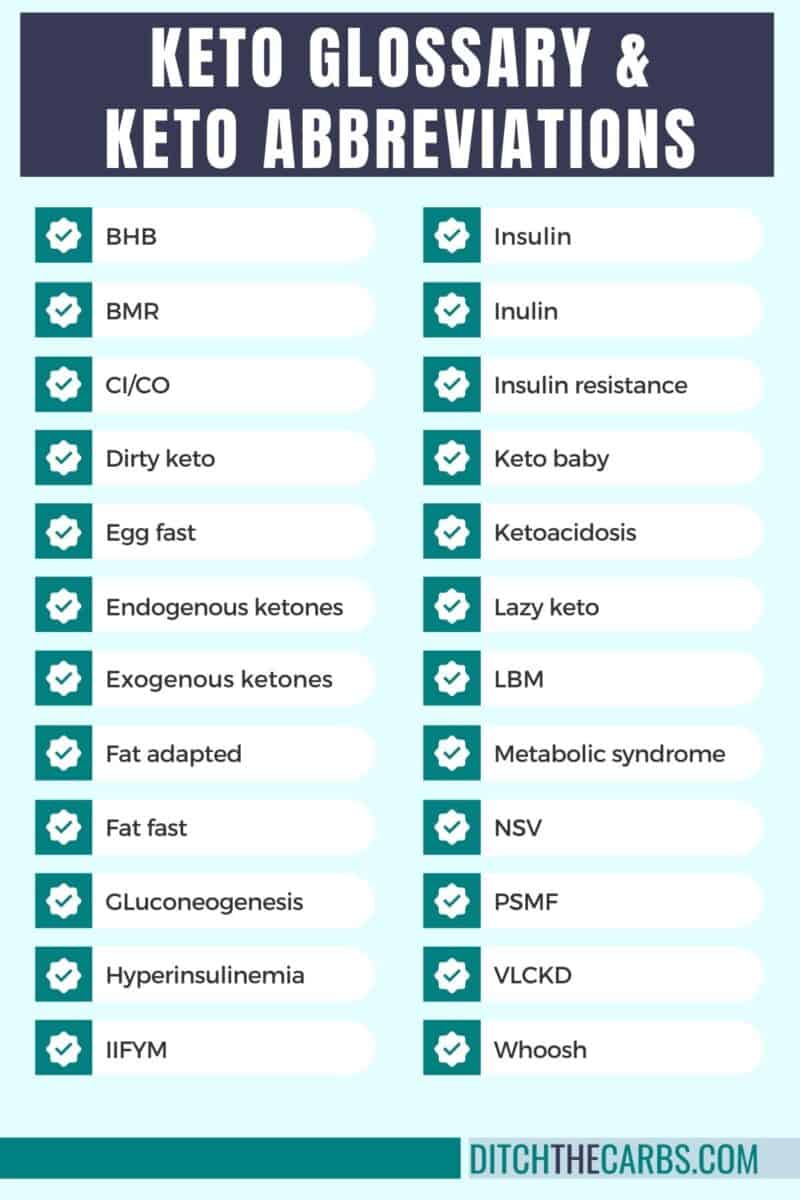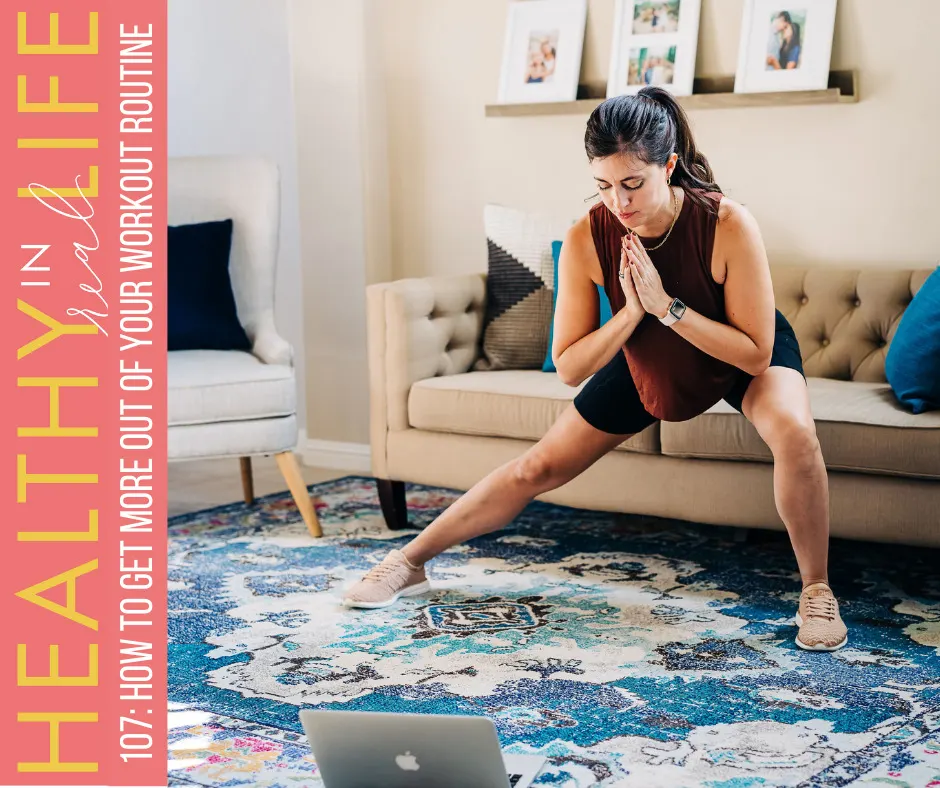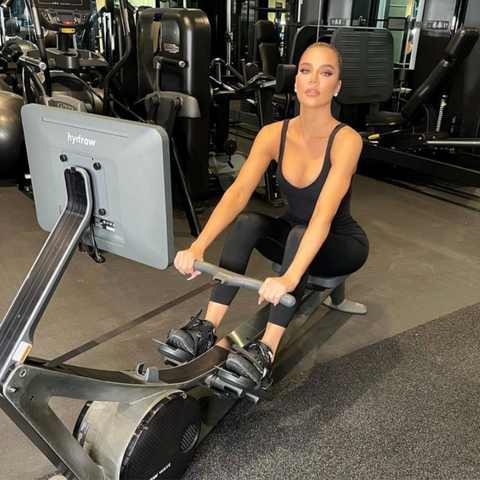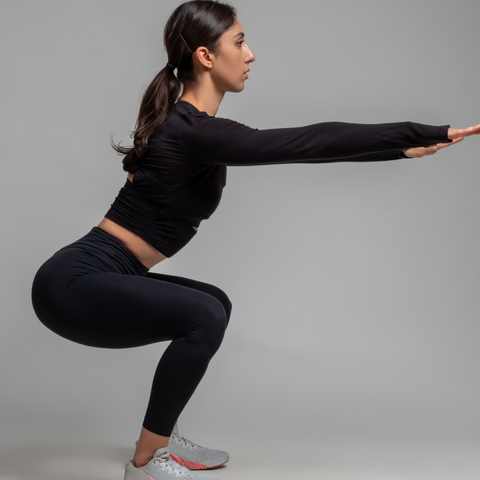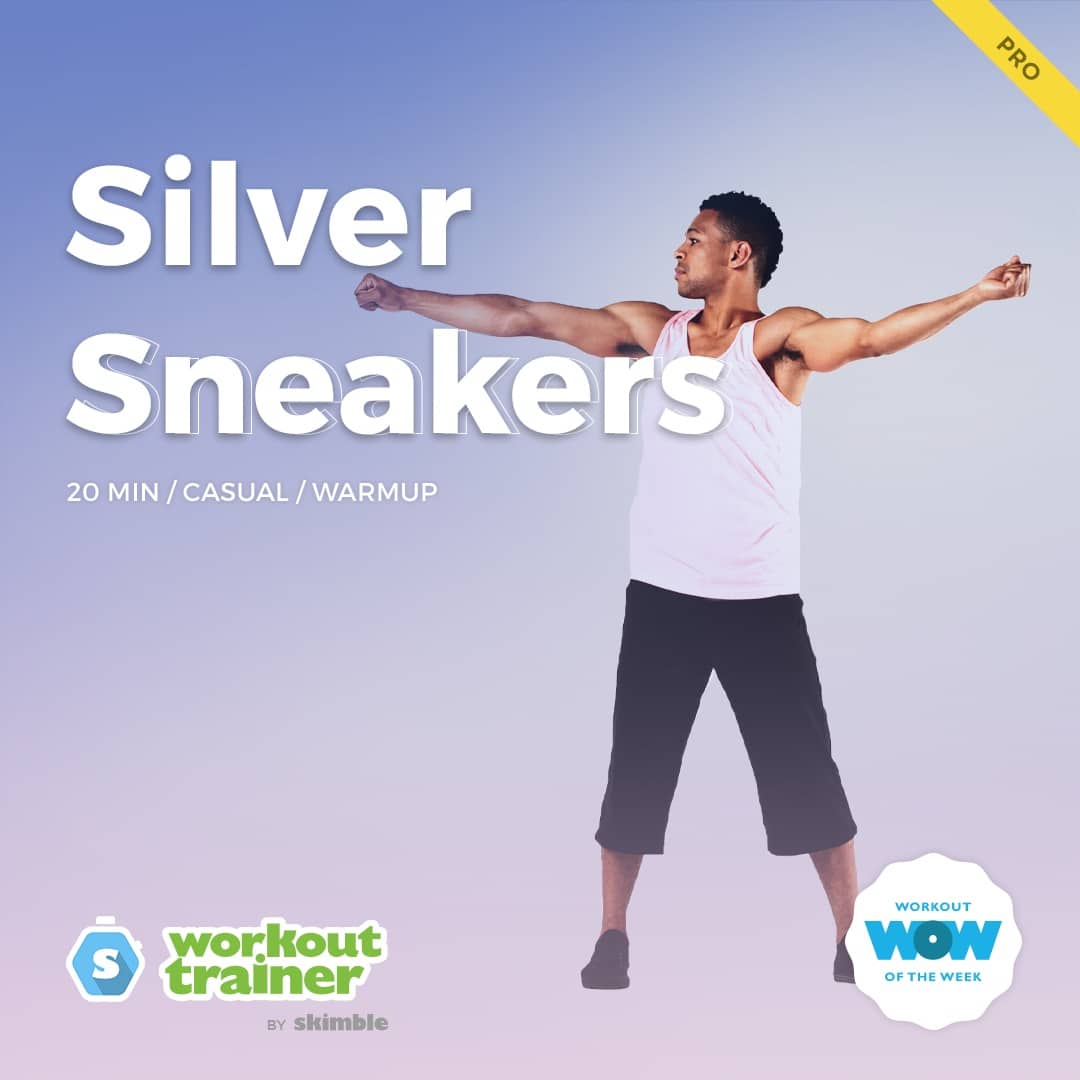Everyone is always searching for that one exercise or shortcut that will finally get them the chiseled abs they desire. After all, abs play a huge role in aesthetics. Shirtless mirror selfies have revolved around muscles like the biceps, chest, and six-pack abs for as long as people have been lifting.
Unfortunately, there isn’t a single exercise or magic trick that will do it. Getting a six-pack requires training them with multiple exercises while following a proper diet. But don’t worry, you don’t need to do 500 sit-ups a day to get there.
I’ve got tons of tips, tricks, and great exercises to help you with your pursuit of abs, whether you’re hoping for a six, eight, ten, or even twelve-pack. Let’s get into the best abdominis exercises!
Table of Contents:
- Rectus Abdominis Muscle Anatomy & Functions
- How Do You Activate The Rectus Abdominis?
- Why Should You Build Your Rectus Abdominis Muscles?
- What Types Of Exercises Develop The Rectus Abdominis Muscles?
- 7 Best Rectus Abdominis Exercises
- 4 Best Rectus Abdominis Stretches
- Benefits Of Rectus Abdominis Exercises
- Rectus Abdominis Programming Tips
- What Role Does Diet Play In Developing Your Rectus Abdominis?
- Sample Workout Plan
- FAQs

Rectus Abdominis Muscle Anatomy & Functions
At its most basic level, the rectus abdominis’ primary job is trunk flexion, and it is the muscle responsible for giving you a six-pack.
Let’s dig in more.
Rectus Abdominis Anatomy:
These abdominal muscles sit in front and run on both sides of your stomach. Responsible for the 6, 8, or even 10-pack look (this is highly dependent on genetics), it originates on the pubic crest and pubic symphysis.
The edges of the rectus abdominis are separated from the obliques by the linea semilunaris, a tendinous intersection located on both sides of the rectus abdominis.
Your genetics will determine how many horizontal tendinous intersections you have, which you can read more about in our article on 4 pack abs vs 6 pack vs 8 pack.
Rectus Abdominis Functions:
The main job of the rectus abdominis is flexing the trunk, which occurs when you perform exercises like a sit-up. The rectus abdominis helps bend your body forward, lift your pelvis, and stabilize your body during many movements. It also helps you exhale forcefully, braces your abdominals, and protects your spine during movements like the squat or a deadlift.
The rectus abdominis works closely with the internal and external obliques, transverse abdominis, lower back, and hip flexors to hold your spine in the correct posture.
The muscles I just mentioned create a rectus sheath and run behind and in front of the rectus abdominis. When they work together as a team, they help transfer force between the upper and lower body, which in turn helps us safely perform almost all movements.
How do you activate the Rectus Abdominis muscles?
Simply put, the rectus abdominis is activated when you move your chest and hips closer together. An example of this occurs during trunk flexion, like when you’re doing a sit-up or reverse crunch that brings your hips closer to your chest.
It’s important to note that the rectus abdominis has what is called the upper abs and the lower abs. While these portions of the abs are still just one muscle, with changes in body position and different movements, it is possible to target one area more than the other1. Exercises like a hanging leg raise focus more on the lower abs, whereas a sit-up will target the upper abs.
Other stability exercises like the pallof press, farmer’s walk, and plank activate the rectus abdominis in a way that forces it to work to resist movement. A good program for the rectus abdominis will include movements that activate it both ways.
Why Should You Build Your Rectus Abdominis Muscles?
Just like any other muscle on your body, a bigger muscle is a stronger muscle. To get visible six-pack abs, you will need to grow the rectus abdominis the way you would build your chest with exercises like bench presses and dips.
It’s going to take progressive overload with resistance unless you are one of the very few people genetically gifted enough to have visible abs simply by doing compound exercises.
Aside from the visible benefits of having six-pack abs, strengthening them allows them to function better.
If you neglect to build these muscles, you are leaving all kinds of gains on the table when it comes to increasing your athletic performance, strength for other lifts, and generally improving everyday tasks and movement. I’ll get into this more in the benefits section.
What types of exercises develop the rectus abdominis?
Any flexion movement is going to be crucial for developing the rectus abdominis. Movements like a sit-up, crunch, reverse crunch, standing cable crunch, V-up, bicycle crunch, or hanging leg raise are great for building muscle in your rectus abdominis.
Movements like the RKC plank, weighted plank, farmer’s walk, pallof press, L-sit, and hollow hold are all great exercises that force the rectus abdominis to help with spinal stabilization. Other movements more focused on stabilizing are also great for the rectus abdominis.
Finally, the big compound lifts like squats, deadlifts, standing shoulder presses, and bent-over rows are a great way to target your six-pack while simultaneously hitting other muscle groups and building full body strength.
Don’t forget that this muscle group needs weighted exercises and progressive overload to grow just like every other muscle. Often, people do these movements for body weight and high reps to feel a burn.
This can give you the illusion that you are working your abs, but if this is all you doing, you’re only really improving your abs’ muscular endurance. You also need to focus on hitting the rectus abdominis in a strength rep range.
7 Best Rectus Abdominis Exercises
You now know why you need to train your rectus abdominis, but which exercises should you train them with? Not to worry, as I’m about to go over the 7 rectus abdominis exercises I recommend for the best muscle-building and strength-improving results.
1. Decline weighted sit-ups:

This variation of the sit-up uses a decline bench to increase the rectus abdominis’ range of motion. Using a weight will further help build the upper abs as they work to achieve flexion. You can always start with body weight if needed and progress when you’re ready.
How to do Decline Weighted Sit-Ups:
- Sit down on the decline sit-up bench, and after hooking your legs into place with knees bent, lay back, extending your weight above your chest with straight arms.
- Begin sitting up, bringing your chest toward your hips, and reaching the weight toward the ceiling. Finish in an upright position with arms overhead.
- Slowly lower back down without falling to the starting position; repeat.
2. Hanging knee raise:

A hanging knee raise is one of my favorite ab exercises, as it significantly targets the lower ab portion of the rectus abdominis and the hip flexors. Since this move is done hanging from a pull-up bar, it also trains your grip strength and lats as they activate to maintain position during the movement.
Once you’re strong enough, try adding a dumbbell between your feet to help build muscle in your lower abs.
How to do the Hanging Knee Raise:
- Grab a pull-up bar slightly wider than shoulder width and hang with your arms straight. Use a bar with enough clearance for your legs to hang straight without touching the floor.
- Once you are hanging, make sure you aren’t swinging and begin simultaneously pulling your right and left knee up into your chest as if trying to do a reverse somersault. Your hips should tuck slightly into a posterior pelvic tilt.
- Lower your legs back down until they are straight. Repeat.
3. Barbell ab roll-outs:
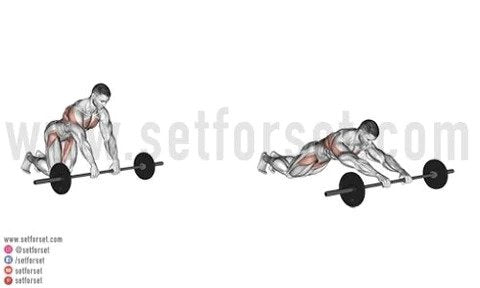
The barbell roll-out is one of my favorite barbell exercises. It’s excellent for the upper abs, yet it works differently than the other exercises on this list as it lengthens your core and strengthens your abs eccentrically.
On the roll-out, your core muscles are working to resist spine and hip flexion, and on the roll-in, they are performing spinal flexion.
How to do Barbell Ab Roll Outs:
- Load your barbell with 10-pound plates and make sure they are circular, so they roll easily.
- Grab the bar with an overhand grip shoulder width apart and move into a plank just for a moment. Now drop your knees to the floor. This is your starting position.
- Make sure your butt and hips are squeezed tight and tucked forward. You should not look like a table.
- Slowly roll the bar forward while keeping your arms straight, rolling as far as you can without letting your hips sag. Your goal is to get your body nearly parallel to the floor but work in whatever range you are able to.
- Flex your abs and pull yourself back in by pressing down into the bar as you pull it back to the starting position.
4. L-sit:
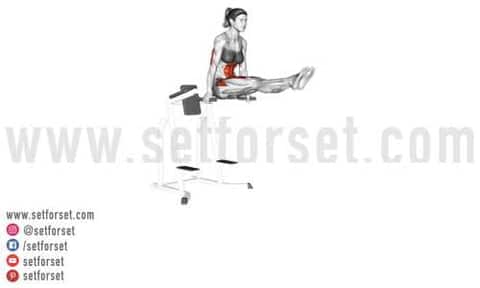
This gymnastic isometric exercise strengthens your entire body while blasting your rectus abdominis, transverse abdominis, and hip flexors as they all work together to stabilize during the hold.
I’m going to explain how to do the full L-sit variation but if you are brand new and need a regression, try holding a knee tuck first.
How to do the L-Sit:
- Set up two flat benches or parallel bars if you have access to them. They should be close enough that you can put one hand on each of them.
- Press your hands flat into the bench or bars, and straighten your legs out in front of you by flexing your quads and locking out your knees.
- Your body should be in the shape of an L with an upright upper body and legs straight in line with your hips. Hold for as long as you can and repeat.
5. RKC Plank:
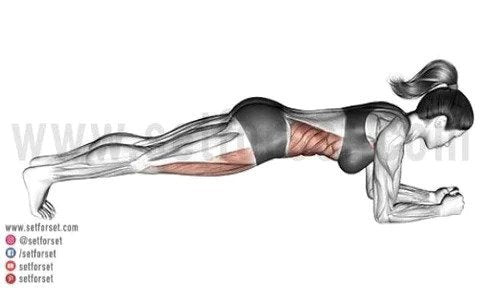
There are tons of plank variations, but this one is fantastic for firing up the rectus abdominis and teaching it to work with the glutes.
How to do an RKC Plank:
- Place your forearms on the floor and your hands together as you set up in a plank with feet hip-width apart and back flat.
- Squeeze your hands together as hard as you can and at the same time squeeze your glutes for maximum contraction. If you do it right, your glutes should be shaking, and your abs should work hard to keep everything straight
- Depending on how much you can feel your glutes, you may need to tuck your pelvis a little forward or back. Once you do, brace your core as if you are preparing for someone to punch you in the stomach.
- Hold for 20-30 seconds of maximum tension and repeat.
6. Farmer’s walk:
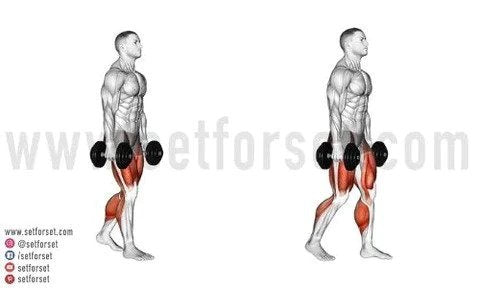
This full-body exercise is as simple as it gets. Pick up heavy dumbbells and walk as far as possible while maintaining good posture. Make sure the weights are relatively heavy.
The core strengthening benefits are out of this world, and your body will be hard at work stabilizing your spine. Ladies, this is also a great exercise to help safely heal diastasis recti abdominis.
How to do the Farmer’s Walk:
- Pick a distance that will take about 20 seconds to walk. This means the weights will need to be heavy, but you can always do a set and adjust if needed.
- Grab your dumbbells, stand with a tall, proud posture, and keep the weights off your hips and sides as if you were trying to make space between your armpit and your body. Think wide lats when you are walking through a door.
- Grip the dumbbells as tight as possible and walk in a straight line taking normal steps.
- Finish the distance and repeat, adjusting the weight as needed. If your distance is 50 feet, you shouldn’t be able to walk 20 more feet with the weight you chose.
7. Medicine ball slam:
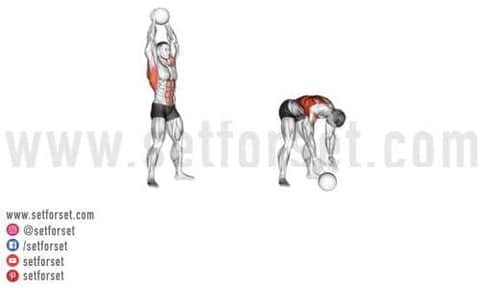
This athletic movement helps build full-body power and explosiveness while training the rectus abdominis as it flexes your trunk during the slam. Medicine ball slams will increase your core strength and can simultaneously be a cardiovascular challenge.
How to do the Medicine Ball Slam:
- Grab a slam ball and hold it over your head with both your right and left arm without leaning back and arching your body.
- Tighten up in your core as if bracing, and slam the ball down as hard as you can while dropping into a squat position.
- The key is to engage your upper and lower body to work as a unit by strengthening your core. Repeat for indicated reps.
4 Best Rectus Abdominis Stretches
I just went over my favorite abdominal exercises for strengthening the rectus abdominis, and now it’s time to go over the best stretches to lengthen everything out. Adding even 1 or 2 of these movements into a mobility routine can go a long way in helping your entire body feel better.
Stretching your rectus abdominis and deep core muscles is just as important as working to build muscle in them!
1. Cat-Cow:
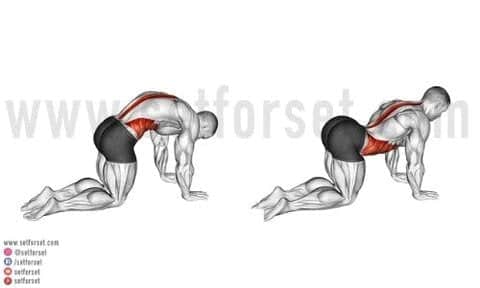
This stretch is fantastic as it moves your upper body through flexion and extension. Not only does it stretch your abs, but it helps with circulation for the discs in your spine.
How to do the Cat-Cow:
- Start on all fours with your knees under your hips and hands under your shoulders. Keep your back flat.
- Inhale and tilt your pelvis back, so your butt is sticking up. Your belly should lower toward the floor but keep your abs pulled into your spine.
- Gently direct your head up toward the ceiling without over-stretching your neck.
- Begin to tip your pelvis forward as you tuck your tailbone. Draw your belly into your spine as you create a hump in your back, and finish by looking into your stomach with your head.
- Repeat for the indicated reps and focus on feeling one vertebrate move at a time as if they are moving up and down the chain in order.
2. Cobra:

This famous yoga pose will help stretch your upper abs and improve your hip and shoulder mobility. Make sure not to overarch your lower back in this stretch.
How to do the Cobra:
- Start lying face down on the floor with your hands placed under your shoulders.
- Press your hips down into the floor as you begin to straighten your arms and lift your upper body as high as you can while puffing out your chest.
- Pause and hold the stretch and return to starting position.
3. Stability ball ab stretch:
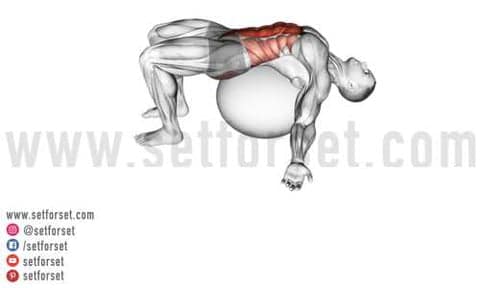
This supine abdominal stretch on a stability ball does a fantastic job of stretching out the rectus abdominis, hips, and chest. It does provide a more unstable stretch, so make sure to maintain your balance and start slow.
How to do the Stability Ball Ab Stretch:
- Lie face up on your stability ball with your legs bent and feet planted on the floor with knees over ankles.
- Your shoulders should be on top of the ball, and your hips should be on the front against the ball.
- Allow your head, back, and hips to stay in contact with the ball as you reach your arms overhead or drop them to the sides while dropping your hips to roll forward on the ball into a deeper stretch.
4. Standing lean back stomach stretch:
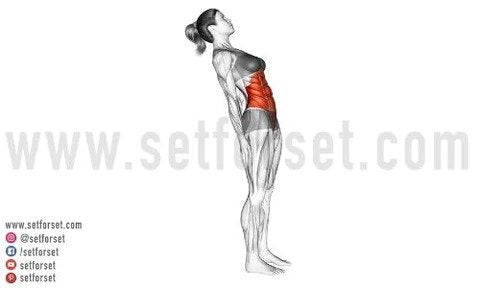
Like the cat-cow, this standing stretch moves your body through hip and spinal extensions. This means you will get a great stretch in both your upper and lower abs.
How to do the Standing Lean Back Stretch:
- Start standing with your body in a straight line. Reach back and put your hands on your butt, or keep them by your sides.
- Keep your legs straight and begin to lean your upper body backward as you slide your hands down as far as you can. Hold the stretch for the indicated time and repeat.
5 Benefits of Rectus Abdominis Exercises
Wondering why it’s important to work rectus abdominis exercises into your workout split? I’m about to give you five good reasons!
1) Better looking abs:
Yay for aesthetics! Your ab muscles will grow by training your rectus abdominis with weighted exercises and eating in a minimal caloric surplus. After a period of growth, you’ll lean out during a cutting phase, revealing your hard work.
I guarantee you’ll love the sight of 6 bricks underneath your skin, and it’s going to feel amazing to take that shirt off at the beach. Everyone is going to be asking how you did it, to which you can respond: “Hard work and some help from my good friends at SET FOR SET.”
2) Improve athletic performance:
Strengthening your rectus abdominis and core as a whole will have a direct carryover into all athletic movements. That’s right, all of them. Sprinting, jumping, rotation, and stabilizing your spine will all improve.
Your body will be better at absorbing and transferring force, whether in sports or everyday movements, like chasing your kids in the backyard.
3) Build a stronger core:
When those abs get stronger, all of your gym lifts will also start to go up. Remember the rectus abdominis’ role in bracing your core? Well, if it’s stronger and able to brace more effectively, your strength for movements like squats and deadlifts will increase.
It also helps stabilize better, allowing you to safely carry heavy things, like during a farmer’s walk or when you’re moving heavy furniture into a new apartment.
Think of the core as the gatekeeper that decides when your body can safely handle more weight. If you strengthen it, it will reward you by enabling you to lift heavier.
4) Support posture and fix imbalances:
The rectus abdominis helps maintain your pelvic tilt. If you know anything about anterior pelvic tilt, it’s a real bummer to deal with. If your hip flexors are tight and your abs and glutes are weak, you will have lower back pain, and your discs will start to move due to the muscles pulling on your spine.
By strengthening your abs, you are helping your body maintain proper posture and fighting off this annoying condition. Imbalanced muscles tell you something is wrong by sending a pain signal. Strengthen the correct muscles, and the pain goes away.
5) Improve breathing:
Strong rectus abdominis muscles allow you to breathe better due to their role in exhalation. Think of any time you’ve been exhausted or felt like you had short choppy breaths.
If you want the ability to breathe more air in, you have to exhale all of the air out forcefully. These muscles will allow you to do a better job once you strengthen them.
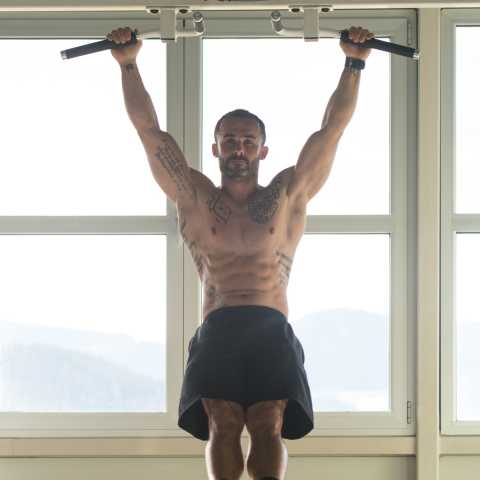
Rectus Abdominis Programming Tips
A portion of your core can be trained with almost every workout as long as you are not overdoing it, meaning you’re not performing every exercise every day or training too hard in one session.
For example, if you’re following a 4-day split, try adding obliques at the end of a strength training session one day, upper abs another day, lower abs the next, and stability-type movements on another day.
- For hypertrophy, focus on 3-4 sets of 10-15 reps and try to increase the weight from week to week.
- For endurance, focus on 3-4 sets of 15-20 reps or timed sets where you perform as many reps as possible.
- For strength, focus on 3-4 sets of 6-8 reps.
Remember that strength also means stabilization, so don’t forget about holds like planks and movements like farmer’s walks or pallof presses. You can even train core on its own day, so it gets your full attention. This would probably work best in a 5-day split.
What Role Does Diet Play in Developing Your Rectus Abdominis?
You will need to build your ab muscles like any other muscle group. This means you will need to go through a period of eating in a caloric surplus to focus on building muscle.
After that, you will likely have to go into a caloric deficit to shed some excess fat if you want to get your body fat levels low enough to see the abs you’ve been building underneath the fat. Don’t forget. The bigger your ab muscles get, the less fat you will have to strip off to see them.
We have multiple meal plans that provide bulking and cutting options. Check out our high protein meal plan or our carb-cycling meal plan for a few great options.
Rectus Abdominis Workout Plan
Here’s a great example of how you can create a rectus abdominis workout. If you’re doing all of these exercises in one routine, I suggest having an exclusive core day in your weekly split, as I mentioned in the programming tips section above.
|
Exercise |
Sets |
Reps |
|
RKC Plank |
2 |
30 seconds |
|
Weighted Decline Sit-Ups |
2 |
8 |
|
Hanging Knee Raises |
2 |
15 |
|
Ab Roll-Outs |
2 |
10 |
|
L-Sit |
2 |
To Fail |
|
Side Plank |
1 |
60 seconds |
|
Medicine Ball Slam |
2 |
10 |
|
Farmer’s Walk |
3 |
20 seconds |
FAQs
If you have any remaining rectus abdominis training questions, we’ll answer them here.
What is the function of the rectus abdominis?
The rectus abdominis flexes your trunk, bringing your chest closer to your hips. It also braces the core and assists with exhalation.
Which exercise does the best job of developing the rectus abdominis?
Decline weighted crunches do the best job of hitting the upper abs and hanging knee raises are excellent for targeting your lower abs.
Which exercise is the best to isolate the rectus abdominis?
You cannot completely isolate the rectus abdominis, but any movement that includes flexion of the spine will target it the best.
Perform Rectus Abdominis Exercise to Improve Overall Athletic Performance
You should now understand the importance of training your abdomen and core as a whole for both aesthetics and performance improvements. It’s great to build six-pack abs, but it’s also essential to improve your core’s function and performance as a whole.
Nobody wants ab muscles that are all show and no go.
Looking for more great core strengthening exercises? Check out our article on the Top 23 Transverse Abdominis Stretches & Exercises!








